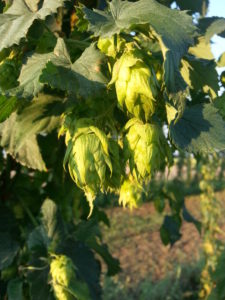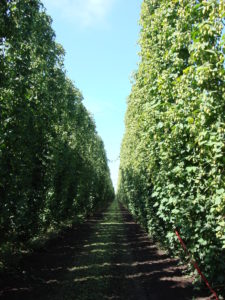It’s a great time to be alive. That is, if your criteria is beer.

Never before have so many devoted their talents to brewing wildly unique flavors of beer. And whether you’re an IPA-loving hop head, a sipper of less-bitter stouts—or simply a classic pilsner or lager lover, hops are an essential part of your favorite brew. Hoppy IPAs continue to dominate the craft brew market, but even the least hop-happy imbiber owes a debt of gratitude to the incredible variety of hops available today.
However, like any other crop, hops are susceptible to economically destructive fungal pests, including two mildews we’ll review here and in a follow-up piece in June. Fortunately, two fungicide registrations, which were recently granted with the assistance of IR-4, will help to keep those problems at bay (and beer in our bellies).
In early March, Ann George, Executive Director of Hop Growers of America, summed things up for attendees of a Senate Ag Committee lunch and learn hosted by IR-4: “No IR-4, no IPA.”
George elaborated the need for IR-4 in a phone interview in April: “If not for IR-4, there would not be a U.S. hop industry. We wouldn’t be able to grow 60 different varieties, each of which has a very different scenario in regards to insect and disease susceptibility.”
The pest management tools available to hop growers have needed to evolve along with this flourishing industry.
“When I came to work for the hop industry in 1987, there were four registered pesticides,” George recalls. “We had one herbicide, one miticide, one fungicide, and one aphicide. We did not have an Integrated Pest Management (IPM) program because we didn’t have anything to integrate.”

She adds, “Most of those compounds were not [materials] we would want to use today. In fact, most have been canceled now because they didn’t make it through re-registration. But our industry made the decision to pursue reduced-risk compounds. And we decided that when we grew up, we wanted to have an IPM program. So we’ve spent the last 30 years pursuing that.”
Effective IPM depends on a range of controls, so growers can count on different management strategies throughout the growing season. This is particularly true when the pest in question is a problem during nearly the entire season, as is the case with powdery mildew.
“Powdery mildew is one of the most devastating diseases affecting hops,” explains Kathryn Homa, a biologist in plant pathology and regulatory submissions at IR-4 Headquarters. “It causes considerable economic damage because hops have a lot of leaves. It can also cause browning and death of the cones, which are the main commodity.”
If you’re a gardener, you’re probably well acquainted with powdery mildew. Maybe you’ve tried the milk-and-water trick to prevent it on your bee balm, or lamented when it turns your zinnias from gorgeous to grotesque. At any rate, powdery mildew in home gardens is a nuisance, but it’s substantially less catastrophic than what we’re talking about here.
“Ornamentals in the landscape are different,” explains Homa. “When garden roses and lilacs get powdery mildew, it’s unsightly. But when it attacks ornamentals during production or food crops such as hops, it really decreases the photosynthetic activity on the leaves, and in turn, reduces crop yields.”
Homa adds, “Powdery mildew begins on hop buds and shoots. It’s not a late-season disease, so growers have to deal with it over an extended period of time. This adds to the cost of growing the crop because the grower can only make so many applications, according to the registered label, and then has to rotate with other fungicide chemistries, which can become costly.”
“Many years ago, fungicides used to be broad spectrum, so one product would control a number of diseases,” she explains. “But now we have reduced-risk fungicides, which control specific diseases. However, when a fungicide is more specific, that means that a pest can overcome it a lot more quickly. So when we get something registered, it may only last a couple of years before [the pest] gains resistance, and then we have to register other products.”
These challenges are part of what make the registration of flutianil, a new fungicide to help battle powdery mildew, so important.
FRAC (Fungicide Resistance Action Committee) codes, according to Pesticide Environmental Stewardship, “can be used to distinguish the different fungicide groups based on their mode of action.” Homa says that for powdery mildew, there are many FRAC codes registered, which means that there are a lot of options for disease control. She explains that “you need a toolbox that has these different groups because if you keep using the same groups, you’re going to end up getting resistance. Then you won’t have anything in the toolbox that works. The registration of flutianil, for example, provides a new mode of action (FRAC class U13) that the pathogen hasn’t overcome yet, and that can be used in alternation with other chemistries.”
The essential toolbox Homa mentions is echoed by George. “In order to grow all of these different hop varieties that are necessary to support a burgeoning craft beer sector, which produces flavorful IPAs that rely on a range of varieties for their flavor compound, we need a very robust plant protection toolbox, and we wouldn’t have that if it wasn’t for IR-4.”
PR# 09190 Hops (Powdery Mildew)
Katie Chriest is a freelance technical writer in Erie, Pennsylvania; kmc503@psu.edu.
